|
Small Fry Yield Big Results
by Craig Lemon
Hatchery Superintendent
March, 2005
The trap nets have been repaired, the boat and engine are ready to go and the
first signs of spring are more evident every day. Flocks of robins are arriving
in the hatchery fields, the geese are pairing up and becoming more vocal each
day, and the shorelines of local lakes are showing some open water. The start
of a new production season at the Hackettstown
State Fish Hatchery is just a few weeks away. The idea behind this story is
to give people around the Garden State a look at what begins annually in March
at Hackettstown and what this process is creating in many New Jersey waters.
|
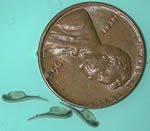
Newly hatched northern pike sac fry.
Click image to enlarge.
|
Broodstock collection begins every March for northern pike and leads into walleye and muskellunge collection through April. Adult fish are brought into the hatchery from lakes and spawned to collect eggs.
These coolwater species eggs hatch in 10 to 15 days and the resulting fish are called "sac fry." These sac fry vary in size from small to tiny. The sac fry grow from 3 to 10 days on their yolk sac. How fast they grow depends on water temperature and fish species.
|
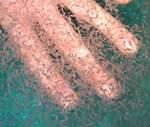
Thousands
of 1-day old walleye sac fry.
Click image to enlarge.
|
|
After
the nutrients in the yolk sac are used up, the fry go through a period called
"swim-up" when they become suspended in the water column and begin free swimming.
They begin looking for a food source, whether it is a natural food such as plankton
from a hatchery pond or fish food dropping from a hatchery feeder.
The
photo shows northern pike fry in a hatchery tank at the "swim-up" stage, about
10 days post hatch.
|
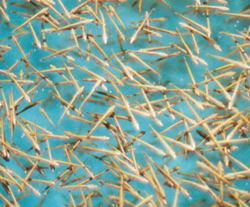
Northern pike swimup fry
Click image to enlarge. |
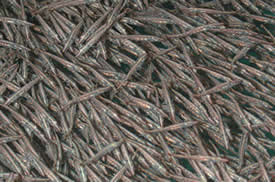
Tiger muskellunge 1-inch fingerlings
Click image to enlarge. |
Once
these fry have accepted feed, they quickly grow into small fingerlings. Northern
pike and tiger muskellunge are grown in the hatchery building on a pellet diet
until they reach stocking size of 7 and 10 inches respectively.
Muskellunge
are a bit more finicky when it comes to starting them on feed. They are fed brine
shrimp for the first seven days and then a mix of shrimp and a high protein pellet
food for the next 14 days. After 21 days the muskellunge are fed pellet feed until
they near the stocking size of 10 inches in October. At this point they are converted
to live forage fish to get them ready for introduction into the wild.
|
Around
May 1st, one million walleye fry are stocked into 2 five-acre hatchery ponds and
grown about 40 days on plankton to a size of 1.5 to 2 inches. Plankton blooms
are created and maintained through weekly additions of alfalfa meal used as fertilizer.
|
Around
June 10th, the five-acre ponds are drained and about 350,000 forty-day old walleye
fingerlings are stocked into lakes and reservoirs. An additional 75,000 of these
walleye are introduced into 4 one-acre ponds and raised on forage fish to a size
of four inches and then stocked into public water in late July.
Almost all of the advanced fingerlings raised at the hatchery are float stocked
by state fisheries personnel or fishing clubs. Float stocking these fish spreads
them out around a water body and allows fisheries personnel to put them in good
cover so they can blend in to their new environment and avoid predators.
|
 Fisheries
Technician Kelly Davis
Fisheries
Technician Kelly Davis
float stocking Greenwood Lake with muskellunge.
Click image to enlarge. |
These fingerling stockings are really starting to pay big dividends in many
of New Jersey's lakes and reservoirs. The following photos (click to enlarge)
show just a few examples of some of the coolwater fishing available just around
the corner from your house.
 Author
with
Author
with
Walleye broodstock |
 Walleye
Walleye |

Tiger muskie |
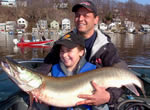 Lake Hopatcong
Lake Hopatcong
Muskellunge |
 Spruce
Run
Spruce
Run
Northern pike |
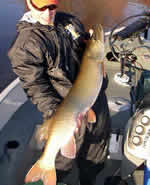
Muskellunge |
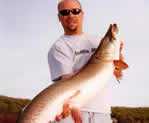
Muskellunge |
 Mercer
Lake
Mercer
Lake
Tiger muskie |
|













